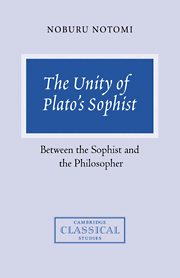Book contents
- Frontmatter
- Dedication
- Contents
- Preface
- Notes and abbreviations
- Division of the Sophist
- 1 How to read the Sophist
- 2 The sophist and the philosopher
- 3 How the sophist appears
- 4 Analysis of the structure of appearance
- 5 Appearance and image
- 6 The sophistic counter-attack on philosophy
- 7 The philosophic defence against sophistry
- 8 The final definition of the sophist
- Bibliography
- Index locorum
- General index
6 - The sophistic counter-attack on philosophy
Published online by Cambridge University Press: 05 June 2014
- Frontmatter
- Dedication
- Contents
- Preface
- Notes and abbreviations
- Division of the Sophist
- 1 How to read the Sophist
- 2 The sophist and the philosopher
- 3 How the sophist appears
- 4 Analysis of the structure of appearance
- 5 Appearance and image
- 6 The sophistic counter-attack on philosophy
- 7 The philosophic defence against sophistry
- 8 The final definition of the sophist
- Bibliography
- Index locorum
- General index
Summary
The sophistic counter-attack in the Middle Part
In the first two chapters I proposed and showed that the basic problem of the Sophist is how to distinguish the sophist from the philosopher; a sophist appears in various guises, so does a philosopher, but to secure the possibility of philosophy, it is necessary to determine what a sophist really is. The third and fourth chapters picked up one key concept of the sophist's art, namely, appearing; appearing to be wise is regarded as the core of the sophist's art. The fifth chapter then continued to examine this concept of appearance in relation to the concept of image. In searching for the sophist, we have thus narrowed down the inquiry and focused on the concept of appearance in accordance with Plato's argument in the first Outer Part of the Sophist. Concerning this characterisation of the sophist, however, difficulties emerge and force the inquirers to suspend definitional inquiry during the Middle Part (236d9–264b8). The difficulties are concerned with appearance, image, falsehood and what is not, and they are raised as if the sophist makes a counter-attack on philosophical inquiry.
In this chapter we shall first see what the counter-attack by the sophist means, and then examine what the difficulties raised in the Middle Part are and how they relate to each other, particularly in relation to the basic problem of defining the sophist.
- Type
- Chapter
- Information
- The Unity of Plato's SophistBetween the Sophist and the Philosopher, pp. 163 - 204Publisher: Cambridge University PressPrint publication year: 1999

